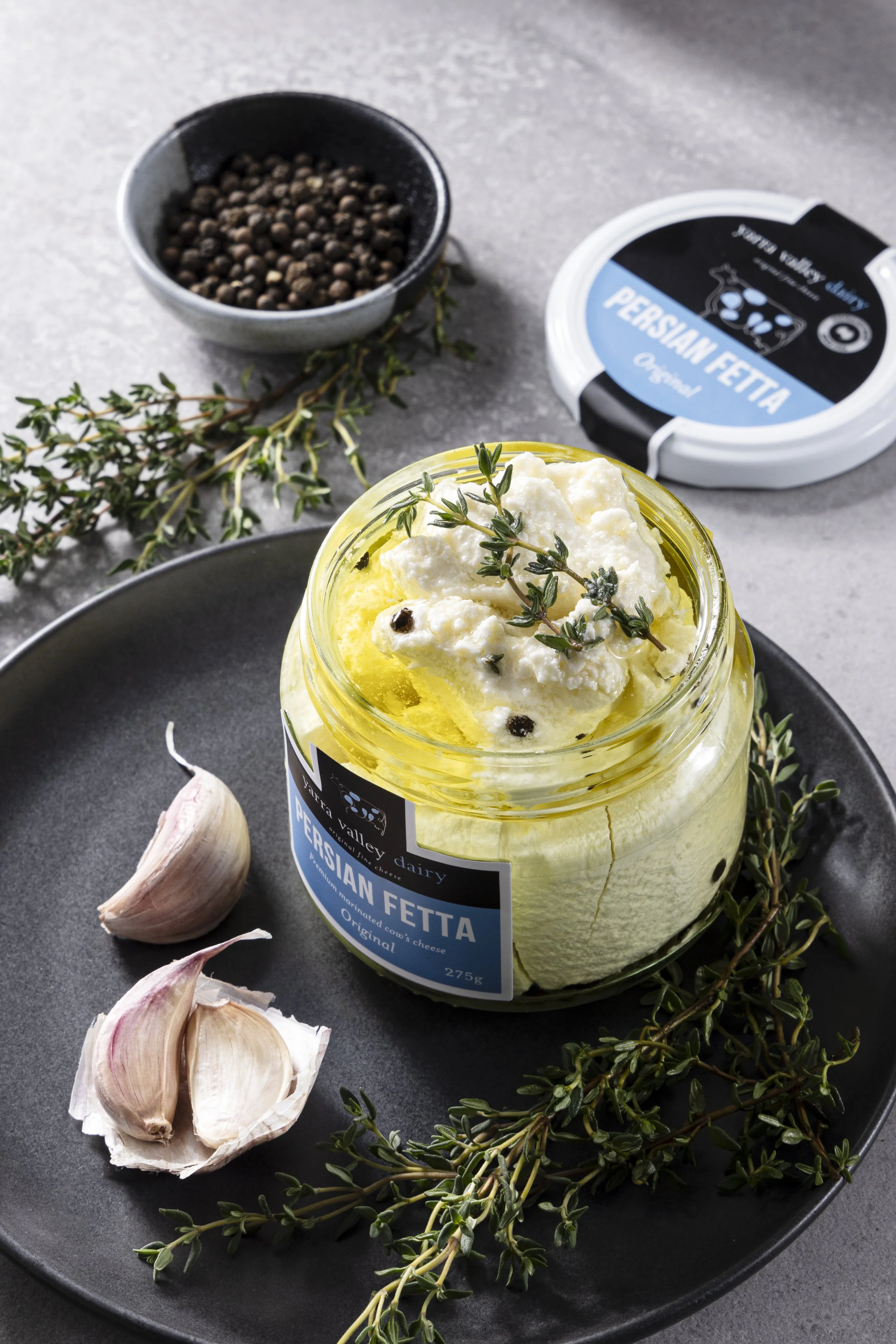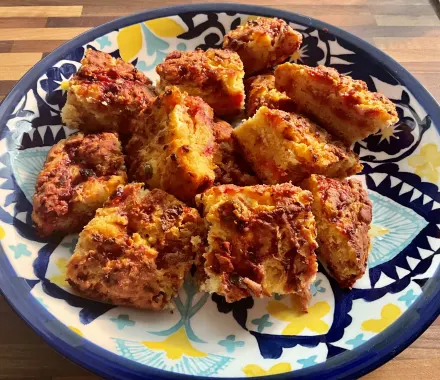Feta or fetta?
- rosemary
- 18 hours ago
- 6 min read
"Keep a jar of Persian-style fet[t]a in the fridge and you'll always have something to smear on veg, swirl through pasta, add oomph to recipes and basically make life better." Sydney Morning Herald Good Food
I have learnt a few things about feta/fetta today and not just the initial thing - that feta and fetta are not the same thing - but a whole lot of other associated stuff too. And let me say that I am not the only one who uses the two spellings somewhat haphazardly. I copied that quote from the Sydney Morning Herald's website and, as you will see, they spelt it incorrectly. Because Persian is spelt fetta - the rest is feta.

Let me begin at the beginning with Alice Zaslavsky, whose recipe for Yarra Valley Dairy Persian fetta and butter beans with red capsicum shown here, was featured in yesterday's Guardian Feast newsletter. It's a rather enticing looking dish to serve for people to nibble at as they arrive at your next family gathering or barbecue with friends. Although, I suppose, very much of our times. A base made of puréed butter beans, fetta and other stuff, peppers, roasted and peeled, and a scattering of herbs and more fetta on top. It even has some crunchy nuts, some herbs, chilli flakes and the perennial drizzle of olive oil scattered on top. Anyone who has made a few of these things can definitely have a go at making up their own version. And marinated Persian fetta is definitely a good choice for the fetta component. So far so not super interesting.

However, in her introduction she let slip that Persian fetta is an Australian invention in spite of the name. She tells us that it was invented by Richard Thomas - an Australian cheesemaking legend, who has worked at the Yarra Valley Dairy - where the Persian fetta began, and also at Milawa Cheeses, and Meredith. She also tells us that the name was inspired because:
"An unexpected stop on a trip to Iran in the 1970s gifted Thomas a chance meeting with a Persian doctor and his breakfast: fresh labneh with soft, still-warm lavash. It was a revelation. On his return, Thomas got to work creating a fresh cheese from goat’s milk (similar to chèvre) and from cow’s milk, marinated and preserved in oil, with an extra “t” to avert confusion with the Greek-style feta, that’s still being utilised by cooks and chefs right across the world."
Which is where I learnt that there is indeed a difference between feta and fetta - although you might wonder where Danish feta comes into it - later. Up to this point in time I wasn't really sure how you spelt it, or even if there was a correct way.

Having a name and an origin story I decided to look into a little further and found a reference to the fact that others ascribe the invention to Mary Mooney the owner and cheesemaker at the Yarra Valley Dairy - almost just down the road from here, and which is always worth a visit. On the Yarra Valley Dairy website it says:
"Mary Mooney, experimented with cheesemaking, creating various soft cheeses in her farm kitchen. Engaging the knowledge and skills of a cheesemaker friend, they set about creating further styles, similar to the cheeses found at the dairy farm gates of regional Italy and France."
I'm guessing the 'cheesemaker friend' was Richard Thomas, so let's say it was a joint effort, although just about everyone says it was Richard Thomas. Although they do say it was at the Yarra Valley Dairy. The date is 1994/95.
The Australian Food Timeline explains the difference of their new invention from Greek feta:
"The cheese is made from cow’s milk, rather than the sheep’s and goat’s milk used for Greek feta. It’s softer and creamier than traditional feta and, although the initial process involves brining, it is not dry salted. The cheese is then marinated in oil, herbs and spices ... their original Persian Fetta marinade included garlic, black peppercorns, fresh thyme, bay leaves and a mix of spices. This was followed by a spicier version containing chilli and another flavoured with dill and chives."
Initially that extra 't' was enough to not upset people, but then others in Australia - particularly Lactos - wanted to get on the bandwagon and took them to court to dispute it as a trademark, which alas for The Yarra Valley Dairy turned out badly:
"a judge ruled that the spelling of fetta was not enough to set it apart from the generic name for the category, and that “Persian”, being a geographical description, could not be owned as a trademark." Australian Food Timeline
Which is why Persian fetta can be found everywhere and made by almost everyone. Same basic principles but with slight variations I guess.
Whilst we are still on the legalities of labelling, they argue in Europe too, where:
"feta sold in the EU can only be labelled as such if it comes from Greece. PDO legislation is enforced within the EU, but doesn't apply elsewhere (unless there's a bilateral agreement)."
Which is why, here in Australia, we also have Australian, Danish and Bulgarian feta. Rachel Clemons wrote a pretty comprehensive article on the Choice website - Feta cheese guide - about almost everything to do with feta beginning with the subtle, and not so subtle, differences.
"Traditional Greek feta is made with at least 70% sheep's milk, with goat's milk often making up the other 30%. The flavour is salty and tangy, the texture dry and crumbly.
Danish feta is made from cow's milk and has a milder, creamier texture. Feta purists argue that 'Danish-style' feta, made using the ultrafiltration method, isn't authentic, but many people prefer its creamier, smoother texture.
Traditional Bulgarian feta is made with sheep's milk and a yoghurt culture, which gives it a particularly tangy taste.
Australian feta is generally a happy medium between the saltiness of Greek feta and the creaminess of Danish feta."
Surely you would think that a totally different process like the Danish style seems to be, would make it into something else and indeed for a while the supermarkets here were labelling their deli blocks of Danish feta as Danish white cheese. And I have to say that the Danish style is my favourite too. It's one of those things that once I start tasting it I can't stop. It's a bit addictive.
Besides I don't think the people who advertise these things and write about them, the recipe writers too, are also pretty unclear. One site that had a whole lof of recipes for the Persian kind called it feta and I also found a lot of people talking about feta writing it as fetta. So we are obviously all confused.
I also found that Nicholas Jordan of The Guardian did a taste test with a whole lot of cheese gurus of the supermarket kind - Australian supermarkets feta and fetta taste test. The conclusion? - Best: Dodoni Feta authentic Greek cheese; Best value: Aldi Emporium Greek style fetta cheese - see Aldi doesn't know it should be feta - or maybe because it's Greek-style it has to be fetta. Who knows, who cares?
Last thing I learnt? The name comes from the Italian 'feta' meaning slice. Which is a bit vague for a particular kind of cheese - for me I guess feta/fetta means salty, pretty white, and softish.
But I'll leave you with a few, specifically Australian Persian fetta recipes that were a tiny bit different from the thousands of recipes you will find for feta: Cherries and chicken - Yarra Valley Dairy; Chilli Persian fetta scrambled eggs - Recipearce; Damper with beetroot, olives and Persian Fetta - Claudies/Brunch; Bacon, egg, thyme and Persian fetta mini breakfast pies - This Little Pig Went to Market
And you can make your own marinated Persian fetta by cutting a block of your particular favourite feta/fetta cheese into cubes and then marinating it in olive oil with whatever you fancy.
YEARS GONE BY
November 21
2023 - Noble thistles
2022 - Nothing
2020 - Missing
2018 - The thermos flask
2017 - Lucky dip - apple fritters
2016 - Corn soup and corn












Fetta feta everywhere and just a touch to taste 😘